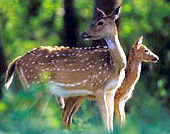 Most of the land is used for agricultural purpose. About 48,675 hectares of land is under cultivation. In the Andaman island, paddy is the main food crop, while in the Nicoabar islands coconut and arecanut are the main crops and field crops as pulses, oilseeds and vegetables are grown, followed by paddy during Rabi season. Fruits as mango, sapota, orange, banana, papaya, pineapple and root crops are grown in abundance on hilly lands. Rubber, red oil, palm and cashew are grown on a limited scale in these islands. Spices as pepper, clove, nutmeg, and cinnamon are also grown. Spices are grown under the multi-tier cropping system.
Most of the land is used for agricultural purpose. About 48,675 hectares of land is under cultivation. In the Andaman island, paddy is the main food crop, while in the Nicoabar islands coconut and arecanut are the main crops and field crops as pulses, oilseeds and vegetables are grown, followed by paddy during Rabi season. Fruits as mango, sapota, orange, banana, papaya, pineapple and root crops are grown in abundance on hilly lands. Rubber, red oil, palm and cashew are grown on a limited scale in these islands. Spices as pepper, clove, nutmeg, and cinnamon are also grown. Spices are grown under the multi-tier cropping system.
In the South Andaman forests, there is abundant growth of epiphytic vegetation as ferns and orchids. In the Middle Andamans there are mainly deciduous forests. In the North Andaman region there are mainly climbers. In the North Nicobar Islands, there is complete absence of evergreen forests. Grass lands are common in Nicobars, while decidious forests are common in Andaman Islands. There are an abundance of timber in the Andaman forests. There are more than 200 varieties, out of which 30 are considered to be of commercial. Major commercial timbers are, Marble wood, Padauk, Silver Grey, Chooi, Kokko. The Padauk variety is used for making furnitures. The tree, Elaeocarps sphaericus, (used for making rudraksha) dhoop and raisin trees also are found here.
 There are many varieties of forest mammals found in these regions. The larger mammals include 2 endemic varieties of wild pigs namely, Sus Scrofa andamanensis from Andaman and S.S.nicobaricus from Nicobar. The spotted deer of different varieties as Axis, Barking deer and Sambar deer are found here in abundance. Elephants are also found here. There are about 26 species of rats and 14 species of bats. There are butterflies and moths of about 225 species. Mount Harriet National Park is one of the richest areas of butterfly and moth diversity on these Islands. There are also the presence of different varieties of shells as Turbo, Trochus, Murex and Nautilus. Shells such as Giant clam, Green mussel and Oyster support edible shellfishery, a few like Scallop, Clam and Cockle is burnt in kiln to produce edible lime. There is also presence of species called Cephalopoda, which includes Octopus, Squid, and Nautilus etc. There are many corals, fishes and sea horses here.
There are many varieties of forest mammals found in these regions. The larger mammals include 2 endemic varieties of wild pigs namely, Sus Scrofa andamanensis from Andaman and S.S.nicobaricus from Nicobar. The spotted deer of different varieties as Axis, Barking deer and Sambar deer are found here in abundance. Elephants are also found here. There are about 26 species of rats and 14 species of bats. There are butterflies and moths of about 225 species. Mount Harriet National Park is one of the richest areas of butterfly and moth diversity on these Islands. There are also the presence of different varieties of shells as Turbo, Trochus, Murex and Nautilus. Shells such as Giant clam, Green mussel and Oyster support edible shellfishery, a few like Scallop, Clam and Cockle is burnt in kiln to produce edible lime. There is also presence of species called Cephalopoda, which includes Octopus, Squid, and Nautilus etc. There are many corals, fishes and sea horses here.



















